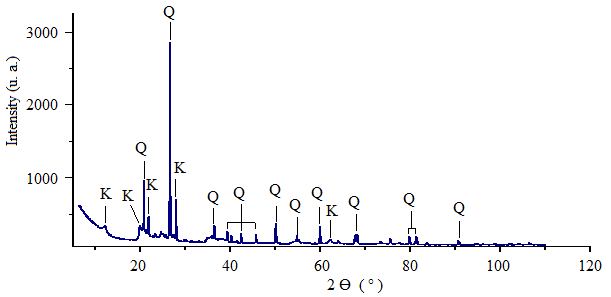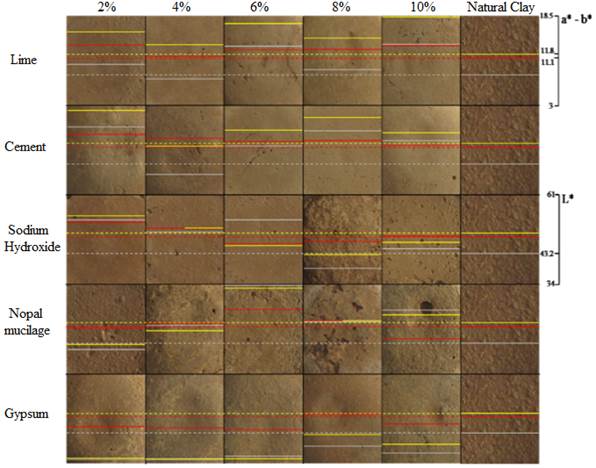1. INTRODUCTION
Within the field of restoration, it is very important to determine the loss of the color intensity of materials used for restoration or preservation because subjective observation can lead to errors in the appreciation of tonalities.
Due to its availability as well as ease in changing its properties and adapting them to application needs, clay is widely used in construction and pottery.
It should be considered that the restoration of historic buildings is an intervention mainly aiming to respectfully recover such cultural heritage, and thus, it requires specialists on the subject for project writing; research and analysis; and work direction and supervision so that the interventions proposed in the project are applied in a correct, respectful, and socially responsible manner.
1.1 Background
This study was performed to complement studies on buildings constructed from raw earth and adobe. This is relevant for their conservation and restoration in Mexico, Latin America, and the entire world because there is a considerable number of artifacts and structures, especially from the preclassic and epiclassic periods, with great cultural value built from these materials (Cuéllar López, 2014). The clay deposit used to extract the materials of this study was selected based on the existence of important Catholic heritage temples on the shores of Lake Pátzcuaro (Pueblo Mágico), Mexico. These important temples for the colony were constructed with a mixed masonry of clay, ignimbrites, and tufa, with proportions conceived according to the European scholars Vitrubius, Palladio and Alberti but with historic technology modified by the Purhépecha ethnic group. Examples of these types of constructions are the Basilica of Our Lady of Good Health [Basílica de Nuestra Señora de la Salud], the temples of Janitzio, Jeráhuaro, Tzintzuntzán, Quiroga, Santa Fe, Ihuatzio, Cucuchucho, Napízaro, Erongarícuaro, Ichupio, San Andrés, San Jerónimo, and others.
Clay is not a translucent or colorless material; it usually has colors ranging from whitish to black (Eleoterio et. al., 2016), including ochres, browns, reds, grays, and less commonly, greens. It was also used to color decorative paintings (Rathossi et. al., 2010; Lin et. al., 2014; Viscarra et. al., 2009; Hu et. al., 2007). Reddish and ochre colors are formed by iron oxides present in the different clay forms (Mahmoudi et. al., 2016; Hradil et. al., 2016; Valanciene et. al., 2010; Li et. al., 2015).
Clay can be composed of crystalline minerals such as quartz, but with dimensions of ≤ 2 µm, and therefore, they are considered to be clay minerals because they are found in clay sediments (Özkan and Zeliha, 2016). Their crystal structure allows them to have hygroscopic volume changes and a large surface area. They are plastic materials, which expand and contract based on their moisture, and thus, this behavior is changed by the addition of different materials to prevent volume changes. These materials are known as volumetric stabilizers or simply just stabilizers. The literature refers to some stabilizers such as lime, which reduces the material’s expansion-contraction, suggesting maximum values of 15% of the clay’s weight. Stabilizers are also used because clay is not water soluble and has limited durability when exposed to the environment (rain, sun, solar radiation, capillary moisture, precipitation in the form of rain, prevailing winds, etc.) unless it is subjected to a high temperature converting it into a ceramic, which is physically and mechanically more stable (Özkan and Zeliha, 2016). Materials such as hydraulic cement, phosphates, aluminum salts, and recently polymers have been used as stabilizers. These materials modify the physical-chemical properties of the clays, thus reducing their expansion in the presence of water (López et. al, 1999).
There are other stabilizing materials such as lime (Anikwe et.al., 2016; Zhang et. al., 2015; Hotineanu et. al., 2015; Khemissa and Mahamedi, 2014; Modarres and Nosoudy, 2015; Sangiorgi et. al., 2016), cement (Vali Vakili et. al., 2016; Wu et. al., 2016: Mardani-Aghabaglou et. al., 2015; Zak et. al., 2016; Gupta et. al., 2017), sodium hydroxide (caustic soda) (Yaowu et. al., 2017; Cong et. al., 2015; Carrol et. al., 1971), white opuntia cactus mucilage and gypsum (Flores Rentería, 2010; Olguín Domínguez, 2008: Velázquez Pérez, 2015; Ahmed et. al., 2014; Kuttah and Sato, 2015; Ahmed and Ugai, 2011). As a result of their studies, these researchers found materials with less changes in volume and similar colors for the formation of adobe and mortars for the reconstruction of cultural heritage in a sustainable and environmentally friendly manner. The addition of organic microfibers to clay does not substantially change the color, and their main benefit lies in supporting dynamic and meteoric requirements (Mattone, 2005), which is not the aim of this study.
Likewise, an earlier study used several additives with proportions between 1% to 10% clay weight. Values above 10% resulted in visual color changes. Smaller changes were observed with percentages of up to 10% clay weight (Flores Rentería, 2010; de León Ambrosio, 2017; Flores Ponce 2018). It was observed that there were no significantly large aesthetic and mechanical changes between the following pairs: 1% and 2%; 3% and 4%; 5% and 6%; 7% and 8%; and 9% and 10%.
The aim is to provide mechanical stability to the clay studied so it can be used, mainly, in restoration but with minimal alteration to the colorimetric properties compared to the original clay.
1.2 Colorimetric Analysis
Colorimetric quantification is a non-destructive test (Gómez 2008; Johnston, 2001; Lamb and Bourriau, 1995), which fortunately can be performed in situ in the case of historic buildings. There are multiple systems to measure color such as the following: Münsell (Albert Henry Münsell, 1915), Ostwald (Friedrich Wilhelm Ostwald, Color Science 1923, Nobel 1909), DIN (Deutsche Institut für Normung or German Standards Institute), Swedish Natural (Skandinaviska Färginstitutet AB, the Scandinavian Institute of Color in 1960, which then changed to NCS), NCS (Natural Color System, USA, 1985), OSA (OSA-UCS, Optical Society of America Uniform Color Space, 1947), Küppers (Harald Küppers, Germany, Color Theory, 1992), etc.
In 1924, the International Commission on Illumination (CIE for its acronym in French, Commission Internationale de l’Éclairage) developed two of the most widely used systems for the evaluation and measurement of color in terms of reflectance, the capacity of surfaces to reflect the spectral light of the sample. The first of them was created in 1931 based on the tri-stimulus values (X, Y, Z), and the second was created in 1976 referring to color spaces (L*, a*, b*).
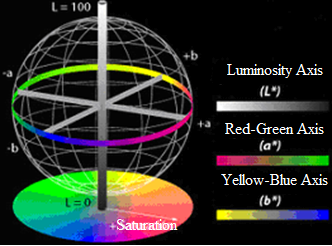
Figure 1 Diagram of the color spaces L*, a*, and b*. The L* axis or luminosity axis ranges from 0 (black) to 100 (white), while the a* and b* axes range from -128 to 127. Those cases in which a* = b* = 0 are achromatic. Therefore, L* represents the gray achromatic scale ranging from white to black, Stephen Westland ©.
The CIE XYZ system specifies chromatic stimuli based on the tri-stimulus values of three primary colors, and the basis of this system was the 2º standard observer. This 2º standard observer is the result of experimentally establishing an equality between monochromatic wavelengths with mixtures of the three additive primary colors (red, green, and blue). On the other hand, the tri-stimulus values are the quantities of these primary colors that specify a color stimulus, and they are known as X (red), Y (green) and Z (blue). For the 2º standard observer, they have values of X = 55.55, Y = 57.33 and Z = 90.25.
Therefore, given the need for a uniform color space, the CIE L*a*b* system, also known as CIELAB, was created. It is a system based on the luminosity L* (light or dark) and the opposing colors a* (a* positive red, and -a* negative green) and b* (b* positive yellow, and -b* negative blue), which indicate the color orientation (Figure 1).
After the color was quantified, it was necessary to quantify the difference between a reference and a sample. The calculation of these differences is one of the most important applications of colorimetry.
Under these terms, colorimetry is a very useful tool in the preservation work of different pieces of art as well as cultural and artistic heritage because during the preservation, the aesthetic or chromatic characteristics of the object cannot be altered, respecting the original work of the creators. To achieve this, a correct choice of the materials to be used during the different interventions must be performed, considering the effectivity of the treatments used and the chromatic modifications that the work can sustain. Thus, it is necessary to perform a colorimetric study before, during and after each restoration to achieve the least noticeable application of materials in the restoration.
2. METHODS
First, a characterization of the clay using X-ray diffraction was performed. This allowed the base composition of the clay to be determined and was followed by a colorimetric analysis of the clay as well as with the different additives to observe their effects on the colorimetric properties. The mechanical properties were not evaluated because that was not the aim of this study.
2.1 Materials Used
The clay originated from the Santiago Undameo Clay Deposit, Michoacán, Mexico, near the capital, located at the coordinates 19º42' latitude north and 101º11.4' longitude west. In addition to the clay, different mineral and organic material additives were used as mentioned.
In the experimental design, percentages of 2%, 4%, 6%, 8% and 10% were chosen according to studies performed by (Flores Rentería, 2010; de León Ambrosio, 2017; Flores Ponce, 2018), and they were compared against a control with no additives.
2.2 Specimen Preparation
The selected clay was mixed with the stabilizers according to ASTM D 6276 standard, where the additives were added to the mixture when combining the materials (clay-addition) and water for kneading at the indicated percentages. The additives were incorporated dry while maintaining a constant temperature between 23-25°C, and the pH of the mixture was verified to be approximately 12.4 (Flores Rentería, 2010). The specimens used for color quantification were stabilized clay pellets of 1.5 inches in diameter and ¼ inch thick, as observed in Figure 3.
2.3 X-Ray Diffraction Analysis
A non-compacted sample was used in the X-ray diffraction analysis to guarantee the random orientation of the particles with respect to the monochromatic incident beam (Dyson, 2004; Benjamin, 1969; Kittel 2005).
In this case, a Bruker AXS model D8 Advance diffractometer with a Linx detector and a Cu X-ray tube with a monochromator were used. Figure 2 shows the X-ray diffractogram corresponding to the clay studied. The peaks obtained were compared with the reflection patterns of the JCPDF (Joint Committee on Powder Diffraction Standards) database. This comparison allowed it to be established that the clay being studied was mainly composed of quartz (Q) and kaolinite (K). In areas where granite rocks and porphides decompose on a large scale, clay is usually found in large kaolin layers, where it is mixed with free quartz and iron oxides of some other minerals present (Dana, 1986). The XRD was performed at the Institute of Physics of the National Autonomous University of Mexico [Universidad Nacional Autónoma de México, IFUNAM). The kaolinites presented surface areas of 15 to 20 m2/gr.
2.4 Colorimetric Analysis
To stabilize the base clay, 5 different materials or products were added: lime, Portland cement, gypsum, nopal mucilage, and sodium hydroxide (caustic soda). The aim of these colorimetric measurements is to establish the chromatic changes that the different stabilizers and concentrations produce compared to the natural clay.
The colorimetric analyses of natural clay and clay modified with different concentrations of additives were directly performed on the specimens with an Ocean Optics USB2000 spectrophotometer with an optic fiber for visible and infrared light, a silica CCD linear detector and a double probe with 400 µm diameter fibers.
The probe consists of six fibers that illuminate the surface and a central probe that reads the scattered light. The equipment was calibrated with a white reference, and the noise, corresponding to the measurement captured in black with the detector’s grating closed, was removed. The integration time for each measurement was 50 ms, and 10 integrations were performed to decrease the noise of the scattered light spectrum.
The specimens were analyzed by the obverse and reverse with three measurements on each side in light, dark and medium zones in order to average the color measurements obtained. Data relating to the luminosity, a* and b* coordinates, chroma (C) and hue (h) were analyzed with the Ocean Optics SpectralSuite® software.
3. RESULTS
The colorimetric measurements of natural clay were established according to Table 1. Plotting these data in the CIE L*a*b* color space (Figure 4) and performing a juxtaposition with the region of the chromatic circle corresponding to these coordinates allowed it to be established that the clay had red and yellow tones, as expected due to the color it obtains when baked.
The clay’s luminosity was found in the center of the CIE L*a*b* system, and thus, it can be considered a slightly opaque material. This characteristic is due to the rugosity of the surface of this compound, which impedes the specular reflection of the light it receives. Thus, if the aim is to replicate the colorimetry of this compound, it is not only necessary to find similar colorimetric measurements but also a similar texture. Moreover, for experimental and regulatory purposes, the clay was passed through a 200 ASTM mesh and retained in 400 ASTM mesh, indicating a diameter of 63.5 to 127 microns.
Table 1 CIE L*, a*, and b* chromaticity coordinates of the natural clay used. The table shows the average of luminosity (L*), amount of red-green (a*) and amount of blue-yellow (b*) the sample has as well as its hue (h) and chroma (C).
| NATURAL CLAY (CONTROL WITH NO ADDITIVES) | ||||
|---|---|---|---|---|
| L* | a* | b* | H | C |
| 43.2± 6.2 | 11.1± 2.8 | 11.8± 4.0 | 46.0± 2.4 | 16.2± 4.8 |
| 37.00 to 49.40 | 8.30 to 13.90 | 7.80 to 15.80 | 43.60 to 48.40 | 11.40 to 21.00 |
The previous results in Table 1 and Figure 4 serve as comparison for the colorimetric measurements with the different additives. In the case of the addition of lime to the clay (Figure 5), it was observed that concentrations of 2, 4 and 8% had comparable colorimetric values to those of natural clay, while concentrations of 6 and 10% did not, as their distances to coordinates a* and b* of the clay had higher values than the standard deviations reported for such data.

Figure 4 Natural clay average of coordinates a* and b* are shown in addition to its tone with the chromatic circle.
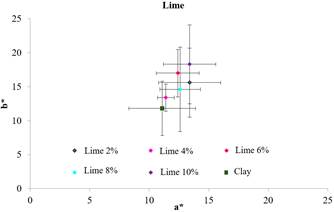
Figure 5 This figure shows, on average, the coordinates a* and b* of the different addition percentages of lime as well as the colorimetric position of natural clay. The tone of the points is summarized using the chromatic circle.
It is possible to analyze this with Figure 5, which indicates the position of the additions compared to the clay. This figure showed that the points corresponding to 6 and 10% additions are the farthest from the clay’s colorimetric position. It is considered that a difference of two units in this colorimetric coordinate system is required for a difference in color to be visible with the human eye.
The amount of luminosity of lime-added clay is comparable with the magnitude of the luminosity of the natural clay because the measured values, with their respective standard deviations, are within the interval of uncertainty compared to the value of the clay.
The colorimetric measurements of clay with different amounts of cement added are shown in Figure 6. Analogous to the analysis for lime, coordinates a* and b* of such additions were compared to those of the natural clay. Based on this, it was found that except for coordinate b* of the 8% addition, all colorimetric distances are lower than the deviations of coordinates a* and b* corresponding to each addition. This allows confirmation that the colorimetric measurements of natural clay and samples with cement added at any percentage are quite similar.
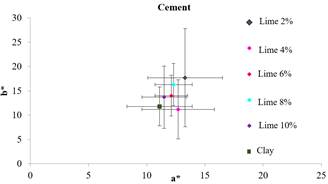
Figure 6 This figure shows, on average, the coordinates a* and b* of the different addition percentages of Portland cement as well as the colorimetric position of natural clay. The tone of the points is summarized using the chromatic circle.
This is evident in Figure 6, where although there are points far away from the natural clay, such as the 2% addition, this value falls within the uncertainty. The samples with cement added also showed luminosity values similar to those of natural clay, but in general, they are lighter. However, the deviations of these values include the value of the natural clay.
In clay with sodium hydroxide (caustic soda), there is a similar situation as with cement; all colorimetric distances fall within the standard deviation interval, except for coordinate b* of the 8% addition. This is evident in Figure 7, where the point corresponding to clay only falls outside the uncertainty marked for coordinate b* of the 8% addition.

Figure 7 This figure shows, on average, the coordinates a* and b* of the different addition percentages of sodium hydroxide as well as the colorimetric position of natural clay. The tone of the points is summarized using the chromatic circle.
Except for the 8% addition, the samples with sodium hydroxide added are more luminous than the natural clay, but the standard deviations of all concentrations indicate that such values are comparable with the luminosity of natural clay.
Regarding clay with addition of nopal mucilage, the colorimetric distance between clay and the 6% addition falls outside of the standard deviation (Figure 8). In this case, it is also possible to say that there is satisfactory similarity between the tones of the samples different amounts of nopal mucilage added and clay.

Figure 8 This figure shows, on average, the coordinates a* and b* of the different addition percentages of white opuntia cactus mucilage as well as the colorimetric position of natural clay. The tone of the points is summarized using the chromatic circle.
The luminosities of the samples with nopal mucilage added are similar to those of the natural clay with the exception of the 6% addition, which turns out to be the most luminous addition of all samples and whose value, even with the standard deviation, is higher than the value measured for clay.
For clay with gypsum added, only the 8% addition falls within the standard deviation range. In general, the remaining additions fall outside this range in either one (2 and 10%) or both coordinates (4 and 6%). This is shown in Figure 9, where the points, compared with previous figures, are more distant from the natural clay point, and thus, this element has the least similar colorimetric values compared to clay. The samples with gypsum added are more opaque than natural clay; 6, 8 and 10% have similar values with those of natural clay, but the concentrations of 2 and 4% are more opaque, despite the deviations.

Figure 9 This figure shows, on average, the coordinates a* and b* of the different addition percentages of gypsum as well as the colorimetric position of natural clay. The tone of the points is summarized using the chromatic circle.
On the other hand, the colorimetric distances between the different concentrations for each addition are shown in Figure 10. This figure shows the comparison of the coordinates a* (red lines), b* (yellow lines) and L* (gray lines) of each additive percentage compared with the same coordinates of natural clay (dotted lines).
Figure 10 shows that the amount of red, with the different additives, has values close to those of the natural clay; this is not the case with regards to the luminosity or the amount of yellow in the modified clay, and thus, these coordinates will definitively determine the similarity of a sample with an additive to natural clay.
As seen in this diagram, the differences between clay with different additives and natural clay are more evident. No clay with an additive is close to the base clay with regards to all of the coordinates because, for the most part, the samples studied are more luminous. This could be because the surface of the pellets is, to a greater or lesser extent, smoother than the surface of the natural clay being studied. Therefore, as mentioned previously, it is important to not only consider the colorimetric measurements of the samples with additives but also their textures.
4. CONCLUSIONS
Based on the colorimetric analyses performed on clay with and without additives, we established that samples with the additives Portland cement, sodium hydroxide and nopal mucilage have colorimetric values that are more similar to those of natural clay overall. The colorimetric measurements of samples with lime added are less similar, but they can still give a similar color compared to those samples with gypsum added, whose only similarity in color with the control is in the sample with the 8% addition (in both cases, lime and gypsum), but it does not match the hue. Therefore, to perform restoring treatments of articles made with raw clay, it is advisable to use either a 6% addition of Portland cement, maximum addition of 4% sodium hydroxide or 4%-8% nopal mucilage. This way, the restored object will, for the most part, have its colorimetric properties preserved.











 nueva página del texto (beta)
nueva página del texto (beta)


